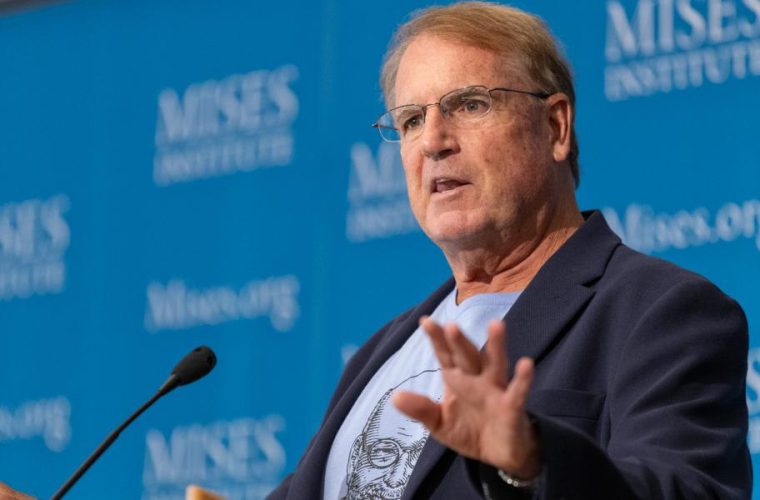
A Short History of the Right to Self-Determination
In his 1927 book Liberalism, the radical classical liberal and economist Ludwig von Mises took a strict and expansive view in favor of secession. Specifically, he noted that respect for the right of self-determination required extant states to allow the separation of new polities seeking secession. He writes:
The right of self-determination in regard to the question of membership in a state thus means: whenever the inhabitants of a particular territory, whether it be a single village, a whole district, or a series of adjacent districts, make it known, by a freely conducted plebiscite, that they no longer wish to remain united to the state to which they belong at the time, but wish either to form an independent state or to attach themselves to some other state, their wishes are to be respected and complied with.
Where does Mises get this idea of self-determination? He did not invent the idea, of course, but at the time was likely drawing upon currents of thought alive and well in Europe in the late nineteenth and early twentieth centuries.
Origins in the American Revolution
The concept of self-determination—albeit not the phrase—was already well-known as the driving force behind the American revolutionaries when the colonies seceded from the British Empire in the 1770s. Historian David Armitage describes the United States’ war for independence as essentially the practical and political starting point for modern ideas of self-determination. While the philosophical roots of self-determination are often attributed to Immanuel Kant, the prototype for a real-life secession movement was found primarily in the American war for independence. Armitage writes: “The notion that “one People” might find it “necessary” to dissolve its links with a larger polity—that is, that it might legitimately attempt to secede . . . was almost entirely unprecedented and barely accepted at the time of the American Revolution.”
The success of the United States in asserting a right of self-determination provoked similar movements in Europe and Latin America in the decades following American independence. For instance, Armitage notes that “language for self-determination” found in the Declaration of Independence would show up repeatedly Latin American, European, and Asian movements seeking political independence.
The Idea Spreads to Europe
In Europe, the concept was well worn by Mises’s time. For example, self-determination was a central theme in Poland’s fight in 1794 to fully separate from the Prussian, Austrian, and Russian states. Poland’s leading separatist was Tadeusz Kościuszko, who had been an officer in the Continental Army during the American Revolution and who was quite familiar with the Declaration of Independence. As Victor Kattan notes, Kościuszko was pushing for self-determination well before the concept entered the common lexicon in Europe and “was inadvertently prescribing and prefiguring national self-determination as it would come to be known over a century later.”1
Mises, who was well-versed in Polish history, was likely aware of this. Mises would have been even more familiar with the battles over self-determination that raged across Habsburg lands a generation before his birth. Chief among these was Hungary’s attempt to secede from the Austrian empire in 1848. The Austrian crown ultimately defeated the Hungarian separatists (and instituted a military dictatorship until 1867), but calls for self-determination in pockets across Europe hardly disappeared.
By the 1870s, the phrase “self-determination” appears to have been increasingly common—especially in the German language. Jörg Fisch, for example, writes that the phrase appears in 1865 in the words of historian Theodor Mommsen, who refers to the “right of self-determination of the Schlewsig-Holsteinian [sic] people.”2 The same phrase (“selbstbestimmungsrecht”) shows up among Czech parliamentarians of the Austrian Imperial Council in 1870. It is also found in French writings (as “droit des peuples de disposer d’eux-mêmes”) at least as early as 1862.3
In Liberalism, Mises explicitly highlights the independence efforts of Poles, “the Germans in Schleswig-Holstein [and] the Slavs in the Hapsburg Empire” in his statements on secession and self-determination.
As happened with other liberal concepts—such as classical-liberal exploitation theory—the Marxists later co-opted and abused the liberal concept of self-determination in the late nineteenth century. Ersatz liberals in America did the same. By the early twentieth century, self-determination was a phrase often used by the likes of V.I. Lenin and Woodrow Wilson, neither of whom were Jeffersonian liberals, of course. Lenin used the term in service of Soviet propaganda against the alleged reactionary states of Europe. Wilson used it to help the victorious Allies dismember Austria and Germany after 1918.
The United Nations and Self-Determination
Even in spite of all this, the core of the idea of self-determination has been preserved, at least in its general application. The United Nations Charter—hardly an expression of Misesian ideals—explicitly lists a right of self-determination among the basic rights it enumerates. The exact meaning of the self-determination language has long been contested, however. When the charter was adopted in 1945, colonial powers such as Britain and France were reluctant to approve any broad interpretation of the concept of self-determination. Winston Churchill, after years of denouncing Germans for violating self-determination rights in Europe, insisted that the concept did not apply to Africans. Eventually, however, many colonies managed to use the UN Charter’s words on self-determination to justify secession from the metropoles.
In response, many UN member states insisted that self-determination via “unilateral secession” only applies to colonial subjects of an obvious nature—i.e., people in places like Kenya and Nigeria. “Noncolonial” subjects, the thinking went, did not have the same rights of secession and self-determination. The basis for this distinction between colonial and noncolonial secession has always been murky, however, largely because there is no undisputed definition of what regions or populations are “colonial” in nature. The definition of this status has at times become so arbitrary that one criterion has been whether or not the colony and the metropole are separated by a body of salt water. This conveniently denies Australian aborigines, North American Indians, and Siberian natives the right of self-determination. Moreover, member states of the UN have frequently insisted that self-determination can only be invoked as “remedial self-determination” in cases of major violations of human rights such as genocide. That is, secession can only be resorted to as a remedy for rights violations in extremis.
Since the 1940s, the concept of self-determination in international law has broadened—although nowhere near Mises’s interpretation. For example, the UN’s 1970 Declaration on Principles of International Law Concerning Friendly Relations and Co-operation among States explicitly expands self-determination beyond colonial subjects. The declaration predictably lists colonial subjugation as a justification for secession, but it also strongly implies that states are only legitimate when “conducting themselves in compliance with the principle of equal rights and self-determination of peoples, and thus possessed of a government representing the whole people . . . without distinction as to race, creed or colour.” A careful reading of this section leads one to conclude that those states that lose the support of “the whole people”—whether in a colonial relationship or otherwise—legitimize political resistance that can “dismember” the state.
In Glen Anderson’s view, this change represents a continued trend toward more expansive “unilateral non-colonial secession.”4 Moreover, the declaration’s language may further open the door to legitimizing the use of secession to address rights violations “in moderato.” That is, international law discourse increasingly recognizes that secession need not be justified only by war crimes and genocide. By this thinking, repeated acts of “discrimination” against a political or ethnic minority are sufficient to justify secession.
An Individual Right, Not a Right of “Peoples”
Of course, none of these interpretations by international law experts or UN officials has any bearing on whether or not self-determination is actually a right. According to liberals like Thomas Jefferson and his ideological descendants in Poland, Hungary, and elsewhere, a right to self-determination and secession are self-evident regardless of what powerful states and their agents might say. Moreover, Mises is careful to clarify that the right to self-determination is an individual right. It is not to be defined as “a right of peoples” or “of nations” as it is commonly understood among the types of people who work for the UN.
In practice, however, successful secession often relies on large social movements requiring collective action. As Allen Buchanan has observed, the fact that secession movements are often brought about by groups of people does not necessarily mean secession is not an individual right. John Locke’s right of revolution falls into this category as well. It is an individual right generally exercised by groups. Jefferson—clearly under the influence of Locke—wrote in the Declaration of Independence that “one people” has the right to “dissolve the political bands” between polities, but it would be a mistake to interpret this right reserved for “the people,” vaguely defined. Rather, as Buchanan describes it, “Remedial Right Only approach to the right to secede can be seen as a valuable complement to the Lockean approach to the right to revolution understood as a remedial right.”5 Buchanan suggests that both revolution and secession should be “understood as the right of persons subject to a political authority to defend themselves from serious injustices” (emphasis added).6
What constitutes “serious injustices,” of course, remains a matter of debate, as is the “acceptable” means of obtaining and enforcing this separation. The Misesian approach would be what Buchanan calls the “pure plebiscite theory” of the right to secede.7 According to Buchanan the theory proposes that “any group that can constitute a majority (or, on some accounts, a ‘substantial’ majority) in favor of secession within a portion of the state has the right to secede.”8 This approach has indeed been used to establish political support and legitimacy for secession movements. Modern examples include Iceland in 1944, Malta in 1964, and Slovenia in 1990. Yet plebiscites are not always used, as the example of the American Revolution makes clear.
A Legacy of the Radical Liberals
In the twenty-first century, the fact that the right of self-determination is recognized at all is thanks to the work of radical liberals of the eighteenth and nineteenth centuries. It was they who established in theory and practice that it is both morally and theoretically sound to break up states into smaller pieces should the state’s subjects—i.e., victims—find it desirable. Nonetheless, much work remains to be done, as the history of the twentieth century shows.
What is clear is that the proper application of the right of self-determination remains in dispute. There is no agreement over how many abuses must be endured at the hands of states before a remedial right of secession can be invoked. There is no agreement over the means by which public support for separation can be asserted. Nor is there agreement over what constitutes colonial subjugation. What is not in dispute, however, is that a right to self-determination via secession exists and that the current borders of the world’s sovereign states are neither sacrosanct nor perpetual. The more radical liberals like Jefferson and Mises have historically interpreted the right of self-determination far more expansively than modern mainstream social democratic theorists. These latter theorists tend to only grudgingly accept a right to secession for people suffering outrageous war crimes. Unfortunately, this position essentially means that the right of self-determination for victims of regime discrimination and abuse are not recognized so long as the state’s crimes fall short of outright genocide, slavery, and similar crimes.
1. Victor Kattan, “To Consent or Revolt? European Public Law, the Three Partitions of Poland (1772, 1793, and 1795) and the Birth of National Self-Determination,” Journal of the History of International Law 17, no. 2 (August 2017): 287–81.
2. Jörg Fisch, A History of the Self-Determination of Peoples: The Domestication of an Illusion (New York: Cambridge University Press, 2015), 118.
3. Ibid.
4. Glen Anderson, “A Post-millennial Inquiry into the United Nations Law of Self-Determination: A Right to Unilateral Non-colonial Secession?,” Vanderbilt Journal of Transnational Law 49, no. 5, (November 2016): 1183–254, esp. 1216–17.
5. Allen Buchanan, “Theories of Secession,” Philosophy and Public Affairs 26, no. 1 (January 1997): 31–61, esp. 36.
6. Ibid.
7. ibid., 39.
8. Ibid.



